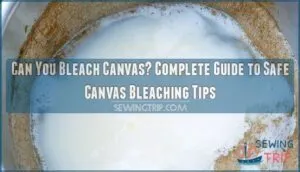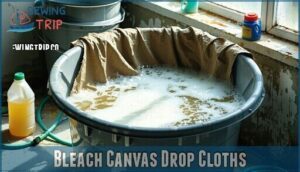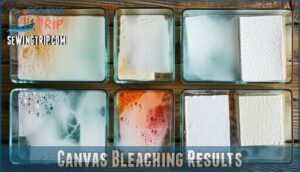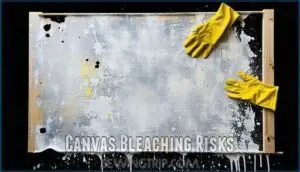This site is supported by our readers. We may earn a commission, at no cost to you, if you purchase through links.
 You can bleach canvas, but it’s not as straightforward as tossing your old sneakers in a bleach bath.
You can bleach canvas, but it’s not as straightforward as tossing your old sneakers in a bleach bath.
Natural cotton canvas responds well to diluted chlorine bleach, while synthetic blends might laugh in the face of your whitening efforts.
Start with a 1:10 bleach-to-water ratio and test a hidden spot first – canvas is thick and stubborn, so it needs time to soak up the solution.
Whether you’re tackling muddy drop cloths or reviving canvas shoes, patience is key.
The fabric’s dense weave means bleach penetrates slowly, but unevenly if you rush.
Getting professional-looking results requires understanding canvas types and proper dilution ratios.
Table Of Contents
- Key Takeaways
- Bleaching Canvas Safely
- Supplies for Bleaching Canvas
- Bleach Canvas Drop Cloths
- Bleach Canvas Shoes
- Remove Mildew From Canvas
- Drying and Storing Canvas
- Canvas Bleaching Results
- Bleach Alternatives for Canvas
- Canvas Bleaching Risks
- Bleached Canvas Projects
- Frequently Asked Questions (FAQs)
- Conclusion
Key Takeaways
- You can bleach canvas successfully, but natural cotton canvas responds much better than synthetic blends – always test a hidden spot first with a 1:10 bleach-to-water ratio.
- You’ll need proper safety gear including rubber gloves and masks, plus work in well-ventilated areas since bleach fumes can be dangerous to your health.
- You can’t rush the process – canvas has a dense weave that requires 3-6 hours of soaking time, and you must rinse thoroughly then neutralize with vinegar overnight.
- You’ll get the best results by understanding that bleaching weakens canvas fibers over time, so use oxygen bleach for gentler treatment or try natural alternatives like sunlight and baking soda.
Bleaching Canvas Safely
Three golden rules govern safe canvas bleaching: preparation, patience, and protection. When bleaching canvas fabric, your safety comes first. Always work in well-ventilated areas—open windows and doors to prevent fumes from building up. This ventilation importance can’t be overstated when working with bleach solutions.
Safety isn’t optional—proper ventilation and protective gear make the difference between success and disaster when bleaching canvas.
Wear protective gear including rubber gloves and masks to shield yourself from harsh chemicals. Choose safe bleaches like oxygen bleach or color-safe options over harsh chlorine varieties. These gentler alternatives reduce fabric damage while still achieving excellent results.
Master proper dilution ratios by starting with one cup bleach per gallon of water. Mix thoroughly in plastic buckets using wooden spoons to avoid chemical reactions. Submerge your canvas completely and check progress every hour. Don’t rush—patience prevents disasters. Remember that with suede, it’s important to restore the texture after bleaching.
After bleaching, focus on thorough residue removal. Rinse multiple times, then neutralize with vinegar solution overnight. This canvas bleaching technique guarantees no harmful chemicals remain. Remember, these bleaching techniques work best when you respect the process and prioritize safety throughout.
Supplies for Bleaching Canvas
Getting your canvas bleaching setup right makes all the difference between success and disaster. You’ll need the right gear before you start lightening that fabric.
Here’s your essential shopping list for bleaching canvas:
- Plastic buckets (2-3 gallon capacity) – avoid metal containers that react with bleach
- Wooden spoons for stirring – won’t corrode like metal utensils
- Rubber gloves and face mask – protect your skin and lungs from fumes
Start with chlorine bleach or oxygen bleach as your main bleach types. Chlorine bleach works faster but can be harsher on fabric.
Fill buckets two-thirds with water first, then add bleach slowly – about one cup per gallon for beginners. Measuring tools help you get ratios right.
Keep white vinegar handy as your neutralizing agent. It stops the bleaching process and removes chemical odors.
Proper safety gear isn’t optional when you’re working with these chemicals. For more delicate fabrics, consider that hydrogen peroxide whitens fibers effectively.
Bleach Canvas Drop Cloths
Whether you’re tackling a small patch or going all-out, bleaching canvas drop cloths transforms that natural tan into a bright, usable fabric.
Start with a 1:16 bleach concentration – one cup bleach per gallon of water in your plastic bucket. You can also use this process to achieve fabric softening for various projects.
| Step | Duration | Notes |
|---|---|---|
| Soaking | 3-6 hours | Check and flip periodically |
| Rinsing | 10 minutes | Thorough hose rinse |
| Neutralizing | Overnight | 8 cups vinegar per gallon |
| Final wash | 2 cycles | Remove residual odors |
This fabric softening process creates perfect material for curtains, pillowcases, or decorative bags, making it a versatile and useful technique for various applications.
Bleach Canvas Shoes
Canvas shoes deserve a fresh look, and bleaching can deliver that crisp, clean appearance you’re after. Before you get started, understand that different shoe types respond differently to bleach. White canvas shoes handle bleaching better than colored ones, which may lighten unevenly.
Transform tired canvas shoes into fresh favorites with the right bleaching technique and a little patience.
Safety precautions are non-negotiable. Wear rubber gloves and work in a well-ventilated area to avoid inhaling fumes. Can you bleach canvas fabric safely? Absolutely, with the right approach.
For bleach ratios, mix one part bleach with five parts water. Application methods include dipping a rag in the solution and applying it to the shoe’s exterior, or soaking shoes in a plastic tub for one to five hours. Remember to condition leather afterward to maintain its suppleness. Check progress frequently to avoid over-bleaching.
Post-bleach care involves thorough rinsing and washing with soapy water. This shoe whitening technique transforms tired footwear into fresh-looking favorites.
Remove Mildew From Canvas
While bleaching canvas shoes can brighten them up, mildew presents a different challenge that requires targeted cleaning canvas techniques. You’ll want to tackle mold and mildew fast before they spread through your canvas fabric.
Mix one tablespoon dishwashing soap, quarter cup borax, and one cup vinegar into a gallon of warm water. This solution kills mold spores without harsh bleach concentration that might damage delicate canvas types.
Dip a soft bristle brush into your mixture and scrub gently in circular motions. For stubborn spots, try hydrogen peroxide applied full strength – it removes mildew without scrubbing.
Safety precautions matter here, so wear gloves and work in a ventilated area to avoid lung irritation. For similar stain issues on nylon, consider how to remove mildew stains.
Different application methods work for various situations. Spray solutions onto affected areas for even coverage, or soak heavily damaged sections. Mildew prevention starts with proper storage in dry conditions and regular inspections for early warning signs.
Drying and Storing Canvas
Once you’ve finished bleaching your canvas, proper drying and storage methods make all the difference between success and disaster. Skip this step, and you’ll find yourself back at square one with mold growth.
Drying Methods and Moisture Control
Start by hanging your canvas in a well-ventilated area where air can circulate freely around both sides. You can speed things up with fans or dehumidifiers, but patience wins here. Canvas that feels even slightly damp will invite mold back faster than you can say "bleach disaster."
Storage Conditions and Long-Term Preservation
- Test dryness by touching multiple spots – canvas should feel crisp, not limp
- Roll canvas loosely around a tube to prevent permanent creases
- Store vertically or flat in low-humidity spaces like closets
- Keep away from direct sunlight and temperature extremes
- Check periodically for moisture or pest issues
Proper canvas care during drying and storage protects your hard work and prevents future headaches. To guarantee longevity, consider controlling temperature and humidity during storage.
Canvas Bleaching Results
Once your canvas is completely dry, you’ll see the true magic of canvas bleaching results. The color change depends on your original canvas type and bleaching time used.
Dark fabrics often surprise you – black canvas turns reddish-orange, while dark blue becomes turquoise or pink. Light colors like beige transform into soft off-white or pinkish tones.
You’ll notice improved fabric softness too. The bleach strength you chose affects how dramatically your canvas whitening appears. Cotton canvas responds best to bleaching canvas treatments, while synthetic blends resist change.
If you soaked for six hours, expect more dramatic results than a quick two-hour dip. For a softer feel, consider that muslin also benefits from bleaching. Don’t panic if your canvas looks darker when wet – this is normal.
How to bleach canvas successfully means patience during the reveal process. Your final results will be lighter, softer, and ready for your next creative project.
Bleach Alternatives for Canvas
Sometimes bleach feels like overkill for your canvas projects. You’ve got plenty of natural alternatives that won’t leave you gasping for fresh air or worrying about fabric damage.
Here are your gentlest canvas cleaning methods:
- Sunlight exposure – Nature’s original bleaching agent that gradually lightens canvas
- Baking soda paste – Mix with water for effective canvas stain removal
- White vinegar solution – Cuts through grime without harsh chemicals
- Hydrogen peroxide – Oxygen-based bleach alternatives that won’t damage fibers
- Lemon juice treatment – Natural acid that brightens while you clean
These bleach alternatives work slower but they’re kinder to your canvas. Fabrics like polyester may resist bleaching, so consider alternatives. Tea tree oil also offers antifungal properties for stain removal.
Baking soda tackles odors while vinegar dissolves stubborn spots. For colored canvas, test these solutions on hidden areas first. You’ll avoid the risks of traditional bleach while still getting impressive results. Sometimes patience beats power when you’re preserving your canvas investment.
Canvas Bleaching Risks
Several canvas bleaching risks can turn your brightening project into a costly mistake.
Fabric weakening tops the list – bleach breaks down cotton fibers, making your canvas tear like paper.
You’ll notice color alteration beyond what you intended, with whites turning yellow and colors fading unevenly across the surface.
Chemical exposure poses serious health risks.
Those harsh fumes can irritate your lungs and skin, especially in poorly ventilated spaces.
Always wear gloves and work outdoors when possible.
Uneven bleaching creates permanent splotchy patterns that look unprofessional.
Once you’ve got these irregular patches, there’s no fixing them.
Canvas shrinking happens when bleach reacts with natural fibers, distorting the original shape and size.
While canvas can be tricky, muslin softens considerably with bleaching.
Fiber damage accumulates over time.
Each bleaching session weakens the canvas structure further, reducing its lifespan substantially.
Canvas damage from over-bleaching can’t be reversed – you’re stuck with brittle, discolored fabric that’ll fall apart sooner than expected.
Bleached Canvas Projects
Once you’ve mastered your canvas bleaching technique, you’ll discover a world of creative possibilities.
Your bleached canvas becomes the perfect foundation for DIY decor projects that won’t break the bank.
Transform your lightened fabric into stunning home accessories:
- Curtain panels – Create airy window treatments with grommets or clips for that relaxed, coastal vibe
- Custom tote bags – Cut and stitch your canvas into market bags that show off your handiwork
- Throw pillow covers – Design casual yet sophisticated accent pieces for your living space.
The fabric softening that occurs during bleaching makes your canvas easier to work with.
You’ve got complete color customization control – from subtle lightening to dramatic artistic effects.
This budget alternative beats buying expensive pre-treated fabrics every time.
For a different approach, consider dyeing canvas projects to achieve vibrant and unique results.
Your bleach-lightened canvas projects will have that perfectly imperfect, lived-in charm that makes handmade pieces special.
Frequently Asked Questions (FAQs)
Can you bleach canvas?
Like painting a blank slate, you can absolutely bleach canvas to lighten its natural color.
Use diluted bleach solutions, test small areas first, and always rinse thoroughly afterward to avoid damaging the fabric fibers.
Do you bleach drop cloths?
Yes, you can bleach drop cloths to lighten their natural tan color.
Mix one cup bleach per gallon of water, soak for 3-6 hours, then rinse thoroughly and neutralize with vinegar overnight.
Can you bleach canvas shoes?
Coincidentally, those canvas sneakers you’ve been avoiding can get a fresh start.
You can absolutely bleach canvas shoes using diluted bleach and a rag.
Remove laces first, apply carefully, then wash thoroughly.
Can you use vinegar on canvas?
You can use vinegar on canvas as a neutralizer after bleaching to remove chemical residue and odors.
Soak overnight in vinegar water, then wash twice to eliminate any remaining vinegar smell completely, which helps to completely remove the smell.
What happens if a fabric is bleached?
Bleaching hits fabric like a chemical eraser, breaking down color molecules and weakening fibers. You’ll see lighter colors, but the material becomes more fragile and prone to tearing over time.
Does bleach turn canvas shoes yellow?
Regular household bleach won’t typically turn your canvas shoes yellow initially.
However, over time, chlorine bleach residue can react with air and cause yellowing.
You’ll get better results using oxygen bleach instead.
Will bleach ruin canvas?
Worried about damaging your fabric?
Bleach can weaken canvas fibers and cause discoloration, but it won’t completely ruin it if you dilute properly and test first.
Use oxygen bleach for safer results.
How do you bleach canvas fabric?
Canvas fabric responds well to diluted bleach solutions.
Mix one cup bleach with a gallon of water, soak your canvas for three to six hours,
then rinse thoroughly and neutralize with vinegar water overnight.
What fabrics cannot be bleached?
Imagine ruining your favorite silk blouse with bleach.
You can’t bleach silk, wool, leather, spandex, or acetate fabrics.
These materials will either dissolve, shrink, or lose their elasticity when exposed to bleaching agents.
How to bleach canvas white?
Mix one cup bleach with one gallon water in a plastic bucket.
Soak your canvas for three to six hours, flipping periodically.
Rinse thoroughly, then neutralize with vinegar water overnight before washing.
Conclusion
Like Goldilocks finding the perfect porridge temperature, you’ve learned that successful canvas bleaching is all about getting the balance just right.
Can you bleach canvas? Absolutely, but only with proper dilution ratios, patience, and testing first.
Natural cotton canvas responds beautifully to bleach, while synthetic blends need different approaches.
Remember to work in ventilated areas, protect your skin, and never rush the process.
With these techniques, you’ll transform tired canvas into fresh, clean material ready for your next project, using bleach and following the right approaches.
- https://www.forestriverforums.com/threads/tent-camper-canvas-mold-and-bleach.321812/
- https://www.clorox.com/learn/how-to-clean-canvas-tent-with-bleach/
- https://dreamdesigndiy.com/how-to-bleach-canvas-drop-cloths/
- https://www.whitearmor.net/forum/topic/16037-canvas-strap-bleaching-help-needed-please/
- https://www.wikihow.com/Bleach-Colored-Canvas-Shoes













